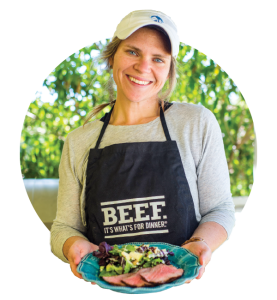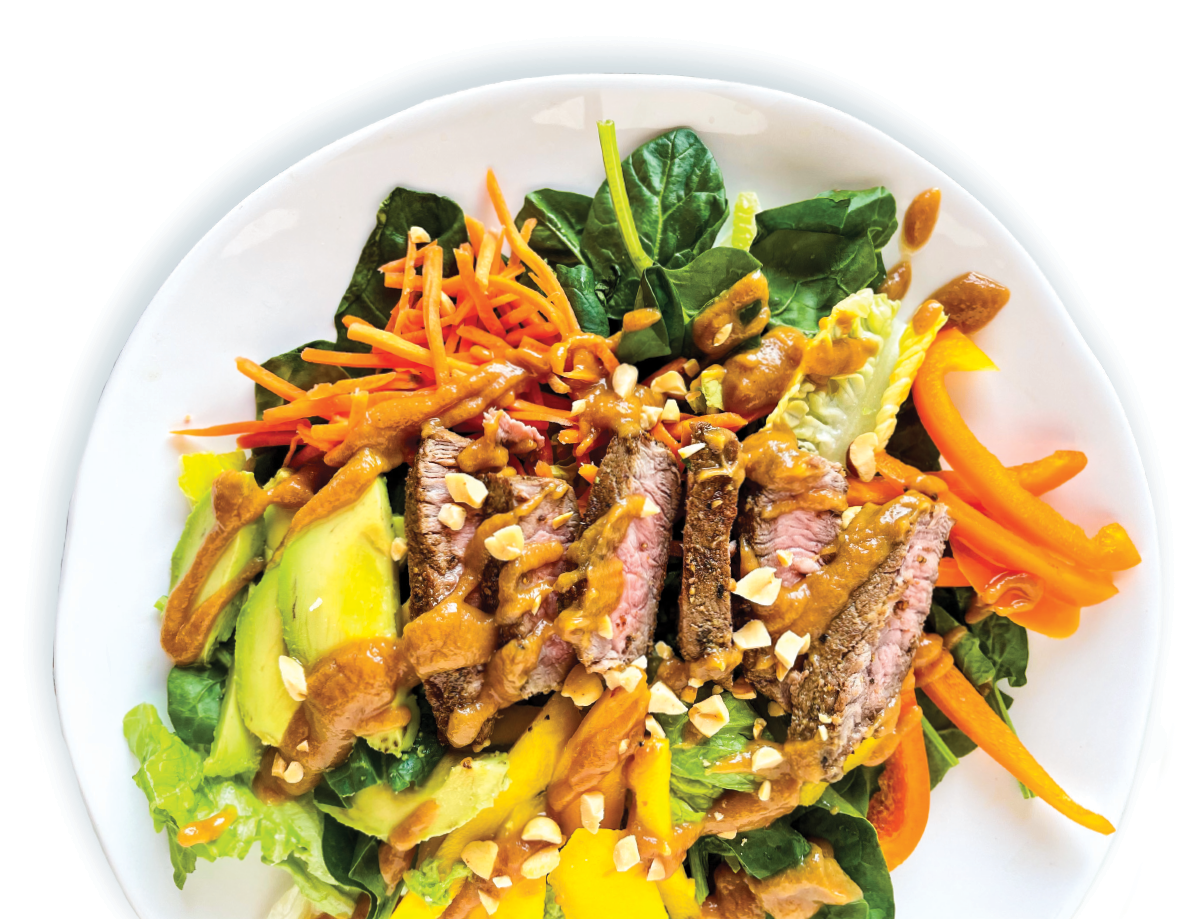“Life is hard enough. Food doesn’t have to be such a guilt-driven piece of our lives,” says Sheri Glazier, who is a registered dietician and electric cooperative member in central Oklahoma. On her ranch, her family of four enjoys a fresh supply of home-raised beef in their balanced diet.
Glazier’s involvement in 4-H food and nutrition projects, and her experiences as a collegiate basketball player, put her on the path to becoming a registered dietitian. But as she entered the field, she saw disconnects between people and their food. First, in their understanding of how food is produced. Equally disconcerting, in how they view food often as “good” or “bad.”
Too frequently for Glazier’s tastes and nutritional understanding, beef became the “bad guy” and a source of guilt for people who enjoy it.
“It’s unfair, really,” says Glazier, adding that a restrictive approach to any food or component of nutrition is counterproductive to overall health. “What we really need is to seek out a solid nutritional foundation so we can have confidence about feeding ourselves and our families.”
Glazier makes it her mission to build this nutritional confidence in people — especially rural women — as the Dirt Road Dietitian. “You may not have access to a grocery store within five minutes, but you can be successful in feeding your family and yourself,” she says.
And that can include serving beef for dinner.
The beef on red meat
Beef and other red meats typically receive negative attention in heart health conversations because of their saturated fat content. The American Heart Association recommends no more than 5-6 percent of daily calories from saturated fat, or about 120 calories in a 2,000-calorie day.
Saturated fat, which is found in animal-based products as well as in tropical oils like coconut and palm, affects the amount of cholesterol in the blood. Higher levels of LDL cholesterol are connected to higher risks of heart disease and stroke.
More recently, an American Heart Association study found high levels of trimethylamine N-oxide (TMAO), which is produced by gut bacteria to digest foods high in choline (an essential nutrient found in animal proteins), may also explain links between red meat and cardiovascular disease. In this 2022 study, high blood sugar and inflammation were also found to potentially contribute to high cardiovascular risk. Blood pressure and cholesterol were not associated.
The difficulty in nutritional sciences, Glazier says, is studies — including the TMAO study — are often built on self-reported observational data. Studies do not always control all risk factors for heart disease (like physical activity levels, smoking, and alcohol or other food consumption). Some foods are easier to report than others, and studies often lump fresh and processed beef together.
“It’s not black and white,” Glazier says. “Everybody says different things. In the 1980s, we were fearful of fat. Now we know we need fat in the diet, but we’re still learning about what types of fat are best for us. There is a lot we’re still learning.”
Beef’s nutritional benefits

Photo courtesy of Sheri Glazier
Glazier points to several studies showing that beef can be part of a heart-healthy diet. These studies were funded, in part, by the Beef Checkoff (a national marketing and research program designed to increase the demand for beef) but conducted independently by university researchers and published in the peer-reviewed “American Journal of Clinical Nutrition.”
“Beef in an Optimal Lean Diet,” a 2012 study, found lean beef could be added to the “gold-
standard” DASH diet, which emphasizes fruits, vegetables, whole grains, poultry and fish. Adding a daily serving of up to 5.4 ounces of lean beef to the DASH diet reduced total and LDL cholesterol just as effectively as the traditional DASH diet. Saturated fat was limited to 6 percent of daily calories for each test group.
Studies in 2018 and 2021 found lean beef could be added to a heart-healthy Mediterranean-style eating pattern, typically considered low in red meat, sugar and sodium and high in fruits, vegetables, whole grains, nuts, seeds and olive oil.
The 2018 study found adults who were overweight or moderately obese were able to improve heart health by adopting this eating pattern, with or without reducing red meat intake. The study compared Mediterranean eating with 3 ounces of red meat (lean, unprocessed beef and pork) per day versus the commonly recommended 3 ounces twice per week.
The National Academy of Medicine recommends adults get about 7 grams of protein for every 20 pounds of body weight. That means a 140-pound person would need about 50 grams of protein per day. A 3-ounce serving of beef packs half that in just about 175 calories, depending on the cut. It also provides all the essential amino acids needed by the body.
In addition to being a nutrient-dense source of protein, beef provides nine more essential nutrients: vitamins B6 and B12, zinc, selenium, niacin, riboflavin, phosphorus, iron and choline. These nutrients play roles across the body — the brain, muscles, bones, teeth, energy, metabolism, and the nervous and immune systems.
Lean on lean beef
The U.S. Department of Agriculture (USDA) defines “lean beef” as 100 grams of beef with less than 10 grams of fat, 4.5 grams or less of saturated fat, and less than 95 milligrams of cholesterol. “Extra lean” beef has less than 5 grams of fat, less than 2 grams of saturated fat and less than 95 milligrams of cholesterol.
A quick tip is to look for cuts that include the words “round” or “loin.” Other lean cuts include chuck shoulder steak, flank steak, flat-half brisket, T-bone steak, top blade steak and some ground beef. Extra lean cuts include bottom round roast, top round roast/steak and eye round roast/steak.
A beef eye of round roast or steak is leaner than a skinless chicken breast (100 grams of round roast has 2.48 grams total fat and 0.9 grams saturated fat compared to 3.24 grams total fat and 1.01 grams saturated fat), according to the USDA FoodData Central database.
USDA quality grades are primarily determined by the degree of marbling — the small flecks of fat within the beef muscle.
Prime is the highest grade, producing the most abundant marbling.
Choice is high quality and will be easier to find than prime. However, it has less marbling than prime.
Select is slightly leaner than prime and choice because it has less marbling.
Beef higher on the meat quality grading scale will have more total fat, but marbling fat tends to be monounsaturated fat, which is considered healthier than saturated fat. Most of the saturated fat is generally trimmed before it gets to the grocery store, says Glazier. “So, we can have really great marbling and still have controlled fat.”
Better health is a journey

Photo courtesy of Kiah Twisselman Burchett
Most beef eaters like to eat beef simply because it tastes good, says Kiah Twisselman Burchett. She was working for the Kentucky Beef Council in 2018 when her health journey began.
Burchett grew up on a ranch in central California, where she developed an appreciation for raising and enjoying beef. But, in her role with the Beef Council, she felt like a hypocrite.
Part of her responsibilities included representing Kentucky beef producers in front of dietitians and nutritionists. She talked about the research and the benefits of beef. She believed the message. However, she felt as though she was doing more harm than good because she did not look healthy, having struggled with weight since elementary school.
Then, in 2018, Burchett began a journey to better health — one that included beef. By the end of 90 days, Burchett had lost more than 20 pounds and gained the momentum she needed to continue that journey. In just over a year, Burchett lost almost 125 pounds.
However, she’s quick to say it has been more about personal development than weight loss. She came to understand food was her comfort, her way to escape difficult situations and emotions. She needed to find new tools to rebuild her relationship with food and with herself.
“I had to learn to change the conversation in my mind around food and my body from negativity and shame to compassionate curiosity and gratitude,” Burchett says. She started learning to eat intuitively, noticing what foods made her feel satisfied and strong, both physically and mentally.
“Beef does feel good for me and my body,” Burchett says. “It keeps me full throughout the day. I love its versatility. I can eat it in so many ways with so many of my other favorite foods.”
Learning to eat intuitively
While Burchett chose not to count calories on her health journey, she did keep a journal. She wrote down the foods she ate and how she felt afterward. Was she bloated? Uncomfortable? Still hungry?
Burchett found years of yo-yo dieting meant she needed to relearn her hunger cues. She also experienced a lot of shame around certain foods. She felt she was bad if she ate a cookie or good because she ate a salad.
“I had to learn how to remove morality from food and be able to ask myself, ‘What sounds good right now? What would feel good physically for my body?’” Burchett says. “That took a lot of time.”
As Burchett came to realize she was using food to soothe herself when stressed, she began to tap into what she calls “compassionate curiosity” to learn more about why she was making certain food choices.
She came to ask herself questions like, “How did I feel before I ate that food?” Sometimes her answer made her realize her emotional state had influenced her food choices, like when she would eat a big bowl of ice cream when frustrated. Instead of judging herself for the action, she would simply ask herself, “Did that food choice help me?”
Mindfulness empowered her to make the best decisions for herself without guilt or pressure and maintain nutritional balance.
“Food is so personal for all of us,” Burchett says. “Food is fuel, but it’s so much more than fuel. Food is culture. It’s family. It’s community. It’s connection. And, yes, it’s comfort, and all of that is OK.”
Planning a balanced meal
A strong nutritional foundation is built on structure and balance. The Glazier family keeps a full schedule, with the farm, work, school, church, family and community activities vying for attention. However, Glazier works to ensure each family member has balanced meals and snacks that nourish their bodies and minds.
She admits dinner is not perfectly balanced every night but doing well 85 percent of the time means there’s no guilt when the family wants more flexibility.
Glazier models USDA’s MyPlate, which makes half the plate vegetables and fruits, one-quarter protein and one-quarter grains (the USDA recommends making half of the grains whole grain). She also tries to include all three macronutrients — protein, carbohydrates and fats — in each meal.
Fiber is another important consideration. Common sources of fiber include fruits, vegetables, legumes, seeds and whole grains. Beef can be paired with many different nutrient-dense foods, including high-fiber options. Some examples of balanced meals with beef include:
- Steak with asparagus, roasted potatoes and rice
- Whole-wheat spaghetti with ground beef and tomato sauce, green beans and a salad
- Egg roll in a bowl with cabbage, ground beef, seasonings and rice
Eating beef is not a problem, but “we have a tendency to over-enjoy,” Glazier says. A good guideline for a serving of beef is about 3 ounces, or the size of a deck of cards. The key is making sure your beef is paired with vegetables and/or fruits making up at least half the plate.
“Whether your fruits and veggies are fresh, frozen or canned, this dietitian does not care,” Glazier says.









